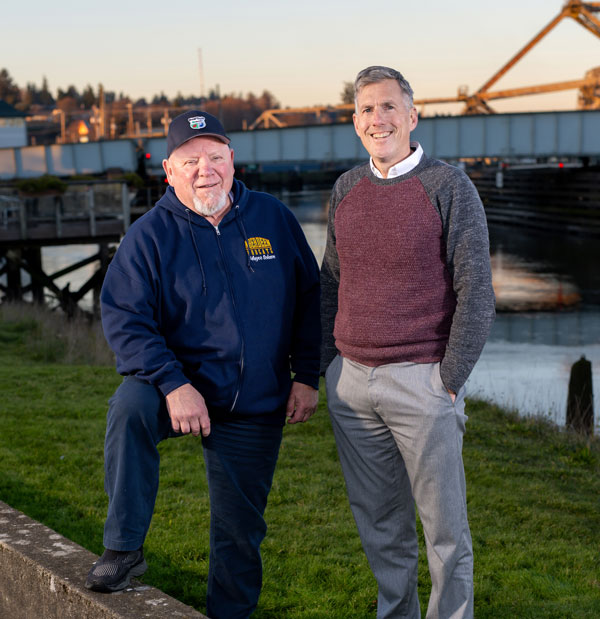by
<a href="mailto:communicationsteam@awcnet.org">Communications</a> | Dec 11, 2023
The cities of Aberdeen and Hoquiam demonstrate how partnership increased city resilience to keep floodwaters at bay.
The cities of Aberdeen and Hoquiam demonstrate how partnership increased city resilience to keep floodwaters at bay.
By: Allyson Meyer
With its flat topography and the second-largest river drainage system in the state, the Chehalis Basin on Washington’s Pacific coast has always been prone to flooding. However, with a changing climate, what once were 100-year floods have become ever more common, prompting a coalition of state agencies, conservation districts, nonprofits, tribal governments, and local governments to create the Chehalis Basin Strategy, a collective long-term approach to building infrastructure designed to minimize the impact of catastrophic weather conditions by bolstering flood resiliency.

Aberdeen Mayor Pete Schave (left) and Hoquiam City Administrator Brian Shay meet at the location of a future levee the two cities are building to prevent nearby rivers from overflowing their banks. Credit: Timothy Rogers Photography
“The Chehalis Basin partnership and strategy all came together when Interstate 5 sustained significant flooding in 2007 and 2009 and was shut down for multiple days,” explains Brian Shay, city administrator of Hoquiam, one of 11 cities and three counties participating in the Chehalis Basin Strategy. “In 2009, parts of I-5 were under several feet of water. That’s when the Legislature decided we needed to solve this problem.”
In 2016, Washington’s legislative body earmarked funding and created the Office of Chehalis Basin within the state Department of Ecology and appointed a steering committee of community leaders (the Chehalis Basin Board) to implement the Chehalis Basin Strategy’s integrated approach—from smaller-scale work in individual communities to cross-city initiatives. One example is the Aberdeen-Hoquiam Flood Protection Project, a flood resiliency infrastructure partnership that includes the restoration of a pump station in a flood-prone area as well as the construction of levees to help prevent nearby rivers from overflowing their banks into the two cities. The project forecasts out 80 to 100 years, using climate change models to determine the necessary height.
“We have a lot of water surrounding us, and both cities are built on the tide flats,” says Pete Schave, mayor of Aberdeen, another Chehalis Basin Strategy partner city. “Over the years we’ve had to overcome that.”
Recognizing that flooding knows no boundaries, the two cities have banded together to work toward solving this complex problem.
“Everyone on each side of Myrtle Street could argue about where the line is between Hoquiam and Aberdeen,” adds Hoquiam Mayor Ben Winkelman, referring to the flood-prone thoroughfare that skirts between the two cities. “We knew we had to do something, but it really required a vision and a dream.”
This sense of interconnectedness and shared mission has forged strong partnerships at local and regional levels, galvanizing support for state and federal funding requests.
“Any time there’s been a success with funding coming in, it’s better than your birthday,” says Schave. “It’s just such a huge project and to see it come to fruition is amazing. It means so much to this area—economically and for the future here.”
Working collectively with U.S. Representative Derek Kilmer, Aberdeen and Hoquiam secured $9.95 million in federal funding for levee final design and permitting as well as support from Federal Emergency Management Agency (FEMA) Building Resilient Infrastructure and Communities (BRIC) grants that have brought in an additional $100 million in funding.
“In back-to-back years we got nationally competitive BRIC grants,” says Shay. “There are no two communities of our size anywhere in the nation that have brought in that kind of money from that program.”
As the design phase of the Aberdeen-Hoquiam Flood Protection Project nears completion and the prospect of construction is within sight, the relief—both economic and emotional—it will bring to these two cities is palpable.
“It will bring resiliency and prosperity to our community,” says Shay. “We conducted a big study in 2018. At that time, the people of Aberdeen and Hoquiam were paying $2.2 million dollars per year in flood insurance—mandatory flood insurance. So, imagine now, all of sudden, the local residents don’t have to pay $2 million a year in flood insurance premiums.”
As the mayors of both cities anticipate a future where flooding is less common in their communities, they are quick to point out that they never could have done it alone.
“There’s just no other way to address a common issue like this without partnering,” says Winkelman.
Adds Schave: “We needed Hoquiam and Hoquiam needed us in order to make a project this big really happen.”